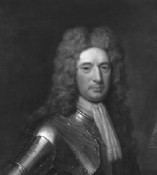Children 3 Name Streynsham Master | Signature Spouse Elizabeth Leigh | |
 | ||
Died April 28, 1724, Lancashire, United Kingdom | ||
Sir Streynsham Master (28 October 1640 – 28 April 1724) was one of the 17th century pioneers of the English East India Company. He served as the Agent of Madras from 27 January 1678 to 3 July 1681 and is credited with having introduced the first administrative reforms in the Madras Government.
Contents
- Early career
- Shivajis Campaign
- Foundation of St Marys Church
- Lingappa Naiks Demands
- Reforms
- Family
- References
Returning to England, in 1692 he bought the Codnor Castle estate and for the rest of his life divided his time between Derbyshire and London.
Early career
Streynsham Master had a distinguished career in the East India Company right from his early days. He served as the Acting President of the Company's factory at Surat during the visit of the President Aungier to the new colony at Bombay. After the return of Aungier, Master served for some time as a member of the Council. In 1670 he led the English in the successful defence of Surat from the Marathas. In 1676, even before Langhorne's removal from power, Master was nominated in advance as the next Agent of Madras in the case of Emergency. In the meantime, until the end of Langhorne's tenure, Master served for a time as the Agent of the Company's factory at Masulipatnam and then Bengal, before he was sent back to Madras to take office as the second member of the Council.
Shivaji's Campaign
In August 1678, the Maratha Emperor Shivaji sent an army of 1,500 horse to capture Poonamallee. While the Maratha army camped near Kanchipuram, news reached the Council at Fort St George by means of the Company's spies that the Marathas intended to proceed upon Madras, Sadras and Pulicat. However, the information proved to be false as the Maratha troops immediately returned to the north from whence they came after the siege of Poonamallee.
Foundation of St Mary's Church
The foundations of St Mary's church, the oldest Anglican church in Madras, were laid during the Agency of Streynsham Master. The foundation of the church was laid on Lady Day, 1678. The construction of the church was completed in two and a half years and it opened on 28 October 1680.
Lingappa Naik's Demands
In August 1678 Lingappa Naik, the Naik of Poonamallee, demanded a large sum of money from the East India Company. The Company's merchant, Kasi Veeranna (Casa Verona), declined and sent him a harsh reply. A month later, when Lingappa visited Kasi Veeranna to express his condolences on the death of the former's wife, he asked the latter the reason why the Agent had not sent anyone to receive. To this Kasi Veeranna delivered an extremely arrogant reply which left the Naik fuming with anger.
When Kasi Veeranna died in 1680, Lingappa sent a Havildar named Shakeel Ahmed to take over the settlement of Madras from the Company. He was promptly arrested by the Company's troops and dispatched across the frontier. Following this act by the English, Lingappa blockaded Madras and prevented goods and supplies from entering the settlement. He demanded that the English agree to pay him an annual tribute of 2,000 pagodas in order to lift the embargo. At one point of time, the situation became so serious that the Directors of the Council even contemplated the thought of moving the Company's factory to Gingee. Neither food nor fuel could be obtained, and the inhabitants starved.
On 9 April 1681 Lieutenant Richardson was sent with fifty of the Company's troops to Gingee. Richardson reached the village of Khandur and besieged the town. At about midnight, Richardson took the town and drove away the Polygar. The required amount of provisions were obtained and transported back to Madras.
On 3 June 1681 Streynsham Master was replaced with William Gyfford as the Agent of Madras.
Reforms
The population of Madras had increased to the point that it seemed difficult to retain the old Choultry courts. Hence, in 1678, the Government of Fort St George set up a judiciary with the Agent and the members of the Council as judges. Two English Choultry judges were appointed to hear cases concerning their Indian subjects.
Master is credited with having introduced the role of a scavenger who was required to remove the dirt and filth of the streets. Scavengers were also empowered to collect the house-tax and other taxes. Watchmen were appointed to guard the settlement at night. Taverns, Hotels, Entertainment-houses and theatres had to be licensed.
Family
He was the son of Richard Master of East Langham, Kent. He married Elizabeth Leigh of Lyme Hall, Cheshire with whom he had a daughter, Anne, and two sons. In 1692 he purchased the Codnor Castle estate in Derbyshire. He served as High Sheriff of Derbyshire in 1712. Master and his wife resided at Stanley Grange in Morley. Among his descendants are Admiral Sir Nicholas John Streynsham Hunt and his son, the Right Hon. Jeremy Richard Streynsham Hunt, M.P.
